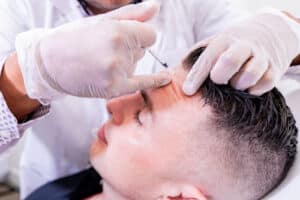Do you suffer from migraines? If you do, you’re all too familiar with the throbbing pain, light sensitivity, nausea, and other symptoms they can bring.
Migraines can be debilitating. Many patients must stop what they’re doing and lie down to ease the pain.
Pain relievers are another common way to cope, but continuously taking medication to get through your day is far from ideal. Sometimes, it can become habit-forming and lead to other less desirable side effects.
When other treatments haven’t provided you the relief you need, it may be time to explore trying Botox. Keep reading to discover how Botox can help treat migraines and if it may be the right treatment for you!
What Are Migraines?

A migraine is much more than a mild headache. It’s a neurological condition.
In addition to intense pain, symptoms can include nausea, vomiting, and sensitivity to light and sound. These can last for hours or even days, making everyday tasks difficult.
There are multiple types of migraines, and symptoms can vary from person to person. The two primary categories are those with aura and those without aura. Aura refers to additional symptoms of your nervous system that occur before and during a migraine.
An aura includes:
- Visual disturbances such as wavy lines and flashes of light
- Vision loss
- A tingling sensation in the arm or leg
- Weakness or numbness in the face or one side of the body
- Difficulty speaking
- Ringing in the ears
Not all migraines are considered chronic. Those with chronic migraines have them more often and experience more severe symptoms.
Someone with chronic migraines has 15 or more headache days a month. They have migraines on at least 8 of those days, and they last at least 4 hours.
The exact cause of migraines is still under research by doctors and scientists. From what’s understood about migraines, genetics may play a role in your likelihood of developing migraines.
The same is also true of the environment around you. Factors like hormonal changes, stress, and sleep changes can trigger a migraine in some people.

Migraines and their causes may be related to how the brainstem interacts with the trigeminal nerve. The trigeminal nerve is a nerve that helps you process facial pain and touch.
An imbalance in your brain chemicals is also thought to be a potential cause of migraines. Although the cause of migraines is not fully understood, treating them is necessary to allow patients to get back to living life.
What is Botox?
Although Botox is most well-known for cosmetic reasons, its uses go far beyond aesthetics. Botox is an injection that contains the botulinum toxin.

The botulinum toxin is a neurotoxin, meaning it’s a substance that affects the nervous system. Botox is derived from the bacteria that causes botulism.
When taken in small doses, it’s completely safe. Injecting Botox into a muscle gives it the ability to paralyze it temporarily.
You can use Botox to reduce the appearance of fine lines and wrinkles, but it can also help treat various conditions. It initially received FDA approval in 1989 to treat involuntary eyelid spasms.
Since then, it has been used for excessive underarm sweating, incontinence, TMJ, and chronic migraines.
How Does Botox Help Treat Chronic Migraines?

Would you like the power to prevent a migraine before it even starts? Botox has been a safe and effective method of treating chronic migraines for the last twelve years.
It works by preventing migraines before the onset of symptoms. During the treatment, your doctor at Jacksonville Eye Center injects Botox around the pain fibers involved with headaches. Injecting Botox into these pain fibers blocks chemicals from transmitting pain signals to your brain.
The treatment only takes about 20 minutes to complete, and the most you will feel is a pinprick. No recovery period is needed, allowing you to return to your normal activities immediately.
The most common side effects are mild, including temporary redness and soreness at the injection site. Because chronic migraines will continue to recur without regular prevention, to continue experiencing the effects of fewer migraines, you should have Botox performed on a set schedule.
After two initial treatments, Dr. Schnipper will discuss whether the treatment works for you. If you’d like to continue, you’ll need to schedule Botox treatments every 12 weeks.
The effects of Botox may take some time to kick in. The majority of patients experience optimal results after the second or third treatment.
Over the last decade, Botox has become the most popular way to treat chronic migraines. More than 500,000 migraine sufferers have tried this treatment, with most experiencing half as many headache days a month.
Is Botox Migraine Treatment a Good Fit for You?
Like any other treatment, Botox is not for everyone. The FDA has only approved this treatment for those who suffer from chronic migraines.
To qualify, you have a headache for at least 15 days a month, with at least eight days being migraines, each lasting a minimum of 4 hours. If you experience less frequent migraines, Botox may not be the best treatment for your migraines. It can prevent regular migraines but is ineffective when an unexpected migraine is already occurring.

Would you like to experience fewer migraines? Schedule a consultation at Jacksonville Eye Center in Jacksonville, FL, today to learn more about Botox for migraines and if it could be the answer you’ve been looking for!
There’s no reason to continue living with debilitating migraines any longer when relief could be yours. Change your life for the better and take control of your symptoms once and for all with Botox. Isn’t it time to live your life once more?

